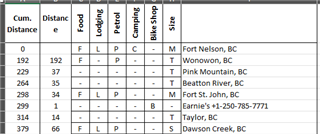A rider would like me to write a data field that alerts them to the next Control Point along his route.
He has a spreadsheet that contains data like this....
The ask is simple... provide a running status of the NEXT Control Point simply comparing his currentDistance vs the distance along the route, and show the distance to the Control Point, the Name, and the amenities (food, gas, etc).
It would be a pain to enter all this into User Settings. I could host a web site I guess and perform a "makeWebRequest" to grab the data, but that looks like it would blow out the small amount of transfer and cause the dreaded -403 status error. I could make multiple web requests... maybe send the current distance and only get back the next few items. Any other suggestions on how a user can make a set of data like this available to a CIQ field? Thanks!


